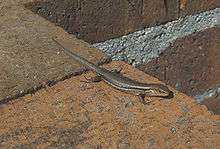Lampropholis
| Indo-Australian ground skinks | |
|---|---|
 | |
| Lampropholis guichenoti, common garden skink | |
| Scientific classification | |
| Kingdom: | Animalia |
| Phylum: | Chordata |
| Class: | Reptilia |
| Order: | Squamata |
| Family: | Scincidae |
| Genus: | Lampropholis Fitzinger, 1843 |
| Species | |
|
14, see text | |
Lampropholis, the Indo-Australian ground skinks or sunskinks, are a genus of skinks in the lizard subfamily Lygosominae. The genus Lampropholis belongs to a clade with the genera Niveoscincus, Leiolopisma and possibly others of the Eugongylus group.[1] They are found mainly in Indonesia and Australia. For similar skinks see genera Bassiana, Pseudemoia, and Niveoscincus.
Diet
Garden skinks feed on larger invertebrates, including crickets, moths, slaters, earthworms, flies, grubs and caterpillars, grasshoppers, cockroaches, earwigs, slugs, dandelions, small spiders, chaparras, ladybeetles and many other small insects, which makes them a very helpful animal around the garden. They can also feed on fruit and vegetables, but the vegetables have to be cooked for the skink to be able to eat it. Skinks especially love bananas and strawberries etc. (no citrus fruit). Garden skinks rely purely on the movement of their prey when hunting. When hunting, the skinks will either hide and wait for prey to come by or actively pursue it (this depends on how hungry they are). Once they have caught their prey, they shake it around vigorously to kill it before swallowing it whole. Once they have had one meal, they begin to actively pursue prey for a short while with their newfound energy. Skinks only need one prey item per 4 or 5 days, buttions are good, thus, making it an ideal pet for small children. They can eat worms if you drain the soil out of them with salt water because worms are too high in soil for them. [2]
Species
The following 14 species are recognized.[3][4][5]
- Lampropholis adonis Ingram, 1991 – diamond-shielded sunskink
- Lampropholis amicula (Ingram & Rawlinson, 1981) – friendly sunskink
- Lampropholis bellendenkerensis Singhal, Sonal, Hoskin, Couper, Potter, & Moritz, 2018
- Lampropholis caligula (Ingram & Rawlinson, 1981) – montane sunskink
- Lampropholis coggeri Ingram, 1991 – rainforest sunskink
- Lampropholis colossus Ingram, 1991 – Bunya sunskink, greater litter skink
- Lampropholis couperi Ingram, 1991 – plain-backed sunskink
- Lampropholis delicata (De Vis, 1888) – delicate skink, rainbow skink, garden skink, delicate grass skink
- Lampropholis elliotensis Singhal, Sonal, Hoskin, Couper, Potter, & Moritz, 2018
- Lampropholis elongata Greer, 1997
- Lampropholis guichenoti (A.M.C. Duméril & Bibron, 1839) – common garden skink, pale-flecked garden sunskink, grass skink, Guichenot's grass skink
- Lampropholis mirabilis Ingram & Rawlinson, 1981 – saxicoline sunskink
- Lampropholis robertsi Ingram, 1991 – grey-bellied sunskink
- Lampropholis similis Singhal, Sonal, Hoskin, Couper, Potter, & Moritz, 2018
Nota bene: A binomial authority in parentheses indicates that the species was originally described in a genus other than Lampropholis.
References
| Wikimedia Commons has media related to Lampropholis. |
| Wikispecies has information related to Lampropholis |
- ↑ Austin JJ, Arnold EN (2006). "Using ancient and recent DNA to explore relationships of extinct and endangered Leiolopisma skinks (Reptilia: Scincidae) in the Mascarene islands". Molecular Phylogenetics and Evolution 39 (2): 503–511. doi:10.1016/j.ympev.2005.12.011 (HTML abstract).
- ↑ Help skinks thrive in your garden. NSW Government, Australia
- ↑ Lampropholis, The Reptile Database.
- ↑ Wilson S, Swan G (2006). A Complete Guide to Reptiles of Australia, Second Edition. Sydney: New Holland Publishing. 512 pp. ISBN 978-1877069468.
- ↑ Wells RW (2002). "Some Taxonomic Changes to the Genus Lampropholis (Reptilia: Scincidae) from Australia". Australian Biodiversity Record (8): 1-24.
Further reading
- Fitzinger (1843). Systema Reptilium, Fasciculus Primus, Amblyglossae. Vienna: Braumüller & Seidel. 106 pp. + indices. (Lampropholis, new genus, p. 22). (in Latin).